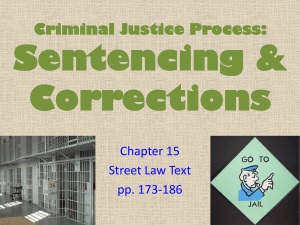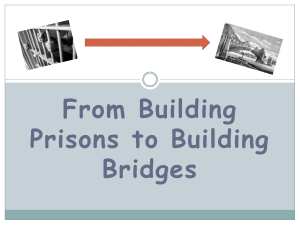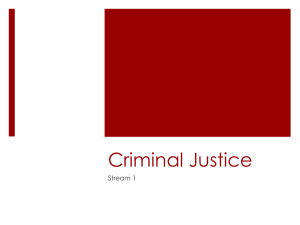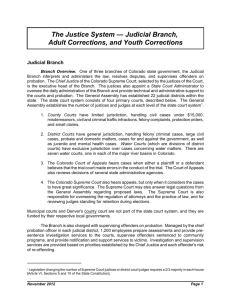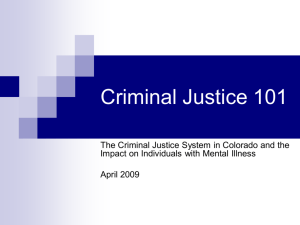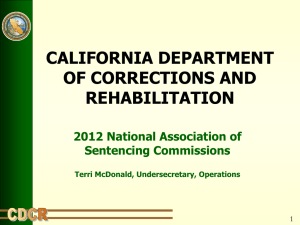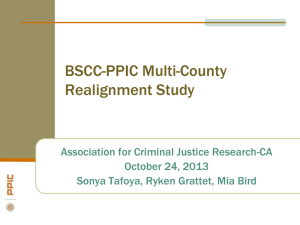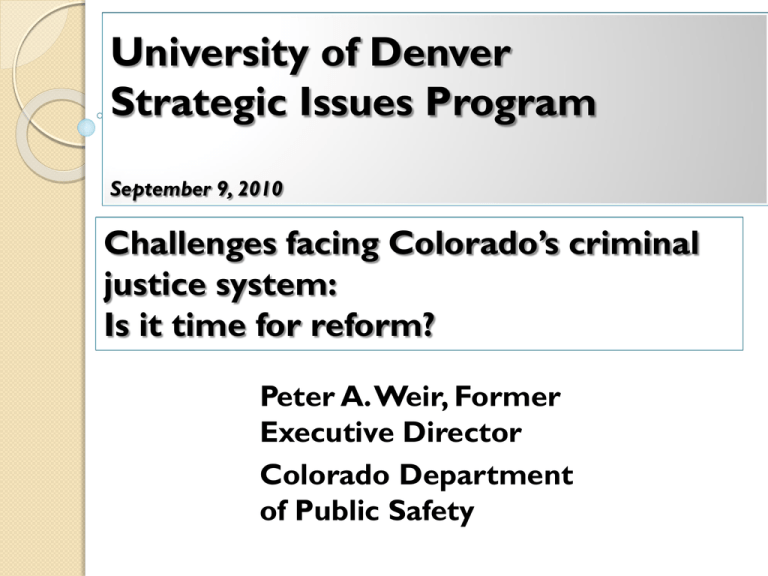
University of Denver
Strategic Issues Program
September 9, 2010
Challenges facing Colorado’s criminal
justice system:
Is it time for reform?
Peter A. Weir, Former
Executive Director
Colorado Department
of Public Safety
Challenges facing government
•Budget
shortfalls
•Budget shortfalls
•Budget shortfalls
•Budget shortfalls
•Budget shortfalls
Challenges facing government:
Budget shortfalls
•Over
the past three years, the governor and
legislature have cut shortfalls totaling $4.3 billion
•The
federal government has provided $1.6 billion
over the past three years to help Colorado
balance the budget.
•Gov. Ritter
said without the federal funding, he
would have been forced to cut another $140
million from public education.
Challenges facing government:
Budget shortfalls
•Gov. Ritter
is reluctantly using money from
medical marijuana registrations to help the state
meet a $60 million budget shortfall.
•The
September revenue forecast will be used to
help shape Ritter's budget for next year, due Nov.
1. Previous forecasts have indicated a $500 million
to $1 billion shortfall in FY2011-12, meaning
more tough decisions must be made
GAO forecasts: Discouraging
through 2050
1980 1985 1990 1995 2000 2005 2010 2015 2020 2025 2030 2035 2040 2045 2050
1. K-12 education
2. Higher education
3. Corrections
4. Medicaid
Challenges: Budget shortfall
Colorado spends 9 percent of its total
general fund expenditures on corrections.
Between 1987 and 2007, Colorado posted
the second highest increase (5.1 percent) in
the proportion of correctional spending in
the U.S.
The DOC budget for fiscal year 2011 is over
$730 million.
In 2007, about 20 percent of Colorado’s
prison beds were occupied by people who
had failed parole.
Colorado's violent vs. property crime arrests
1980-2008
8000
7000
6000
5000
4000
Property
crime rate
3000
2000
1000
0
1980
Violent Crime rate
1985
1990
1995
2000
2005
Colorado crime rates and justice
system expenditures - 1982-2005
Colorado incarceration rates
1980-2005
CO doubled sentencing ranges in 1985
Percentage Increase: Number of Sentenced
Prisoners, Selected States, 1990-2002
224%
216%
190%
171%
146%
141%
131%
124%
123%
116%
114%
132%
101%
97%
90%
80%
68%
67%
55%
48%
47%
37%
35%
32%
25%
22%
Texas
Idaho
W. Va
Miss
CO
Tenn
MT
ND
MN
Utah
SD
HI
Iowa
WA
NV
OK
PA
AK
Calif
IL
MI
RI
SC
MD
NJ
Maine
NY
From: Michael Jacobson (2005), Downsizing Prisons, p. 33
Texas-------224%
Colorado--145%
New York---22%
Overall state
average------80%
Why the increase?
•Longer
•More
sentences
admissions
•Increase
in parole and probation
violators
•Increase
in drug offenders
Nationwide, convictions increased about 18% in the
1990s and prison admissions increased about 60%
SOURCE: Mark Mauer (2007). The hidden problem of time served in prison. Social Research, Vol. 74, No. 2, page701. (Sentencing
Project website)
Percent of Americans Who Prefer Tougher Approach to
Crime or Tougher Approach to the Causes of Crime
1994 and 2001
Tougher
Approach to
Crime
Tougher
Approach to
Causes of
Crime
1994
2001
42%
32%
48%
65%
Michael Jacobson (2005), Downsizing Prisons; Source: Peter D. Hart Research Associates, Inc.
(2002) The New Politics of Criminal Justice, Washington, D.C.
Challenges
In July, 22,813 were in prison and 9,000 were on
parole (500 fewer in prison than one year ago)
11,000 people entered prison each year and
serve about 22 months
10% of the DOC population in FY2009 was
serving time for a parole technical violation
49% of the population are past their parole
eligibility date
78% have substance abuse problems; 23% require
sex offender treatment; 61% have vocational
problems; 30% have academic problems.
July 2010 Statistical Bulletin; Colorado Department of Corrections Statistical Report, FY 2009
Challenges: Cost and
Success Rates
Average cost of prison: $32,300/year
3-year return-to-prison rates: 53%
New crime: 18%
Technical violation: 35%
22% is the return-to-prison rate when NOT
released on parole (new crimes)
Colorado Department of Corrections Statistical Report, FY 2009
Colorado’s CJS: Challenges
Cost of imprisonment
Lack of effectiveness of imprisonment,
based on recidivism rates
Implementation of established Evidence
Based Practices to reduce recidivism
Method to address challenges:
Colorado Commission on Criminal
and Juvenile Justice
“Are you just pissing and moaning or can you
verify what you’re saying with data?”
Colorado Commission on
Criminal and Juvenile Justice
Established in 2007, began work in 2008
Multidisciplinary membership of 26
professionals
Mandated to focus on evidence-based
recidivism reduction and cost effective
expenditures of limited criminal justice
funds
Mandated to assess the effectiveness of
sentences imposed to meet the purposes of
sentencing and the need to prevent
recidivism and re-victimization
C.R.S. 16-11.3-103
Pyramid of Evidence-Based Practices
National Academy of Sciences National Research
Council 2008 Report on Parole, Desistance from Crime,
and Community Integration.
Statistical method that synthesizes many individual
studies into one large study with many subjects;
adheres to pre-established protocol to select
studies; calculates an average effect size to reduce
bias and ensure comprehensiveness.
Pyramid source:
Co-Occurring
Center for
Excellence
(COCE), funded
through the
Substance Abuse
and Mental
Health Services
Administration
(SAMHSA).
Available at
http://www.coce.sa
mhsa.gov/cod_res
ources/PDF/OP5Practices-8-1307.pdf
Most Colorado
studies of criminal
justice programs
Anecdotal events often drive policy
Evidence: Does incarceration
reduce the crime rate?
The empirical evidence is increasingly clear that the increased
use of incarceration for low-rate, non-violent offenders
prevents and deters few crimes.
◦ PUNISHMENT
Employment, marriage, and aging are linked to desistance from
crime.
Public policies that block employment and other opportunities
for ex-offenders to resume a regular life in the community
eventually lead to higher rates of failure.
◦ SEALING OF RECORDS
Evidence: The time immediately
following release from prison is the
riskiest for the offender and the public
• Assessing
risk and service needs of offenders at the
point of release (DOC),
• Targeting services that meet at least 5 of the
offenders most pressing needs (housing, employment,
substance abuse treatment, antisocial peer
associations, and criminal attitudes) in the weeks and
months immediately following release, and
• Provides the most cost-beneficial approach to
reducing recidivism and increasing public safety
Evidence: Based on 30 years of research
(handout)
Eight Evidence-Based Principles for recidivism reduction in corrections
#1. Assess offender risk/needs using actuarial scales.
2. Enhance intrinsic motivation—help offenders engage in treatment.
3. Target interventions.
a. Risk Principle: Prioritize supervision and treatment resources for higher risk offenders.
b. Need Principle: Target interventions to criminogenic needs.
c. Responsivity Principle: Be responsive to temperament, learning style, motivation,
culture, and gender when assigning programs.
d. Dosage: Structure 40-70% of high-risk offenders’ time for 3-9 months.
e. Treatment: Integrate treatment into the full sentence/sanction requirements.
4. Skill train with directed practice (use cognitive behavioral treatment methods).
5. Increase positive reinforcement (4 positive for every negative sanction).
National
Institute of
Corrections
nicic.org
6. Engage ongoing support in natural communities.
# 7. Measure relevant processes/practices.
8. Provide measurement feedback: Client outcomes and quality of service delivery
Example
EBP #1
Assess offender needs and risk levels
Example: Colorado Actuarial Risk
Assessment Scale for Parole Release
Risk Level
Very low
Low
Medium
High
Very High
Probability % of DOC
of
population
recidivism
18%
11%
24%
17%
33%
15%
45%
23%
77%
33%
Legislation 2010
HB 10-1352
Controlled Substance and Marijuana Penalties
Rep. Waller
Sen. Steadman
HB 10-1360
Parole Placement for Technical Violation
Rep. Pace
Sen. Steadman
HB 10-1374
Parole Changes Evidence-Based Practices
Rep. Ferrandino
Sen. Penry
Challenge
Implementation of Evidence-Based
Practices (EBP) to reduce recidivism
•Changing
organizational culture
• Parole Board
• Technical Violations Parole Officer
•Introductory
training all disciplines and levels of
management
•Ongoing training for line staff
•Ongoing evaluation (research) to ensure
implementation
Challenge: Changing organizational
cultures to implement EBP
#7. Measure relevant processes and practices.
•What
data is collected regarding inmate/offender assessment and case management?
•Is
the information reliable? Is it adequate to answer questions about adhering to
evidence based practices?
•Is
the information easily retrievable so that managing staff can review their efforts?
•How
are incremental inmate/offender changes measured while they are incarcerated
and under supervision?
•What
are the outcome measures and how are they tracked?
•Are
staff performance evaluations based on use of evidence based practices and
successful supervision techniques? How is staff performance measured? What data is
used? How is that data collected? How is it used to provide feedback to the parole officer
or case manager?
•When
practices are not well implemented, what is the approach for improvement?
National Institute of Corrections nicic.org
Recommendations
Resources for training and research are cut
during budget reductions
Decisions need to be linked to both research and
public expenditures
Need to develop research-based performance
measures
Common goal: recidivism reduction
Alternatives to incarceration for appropriate
offenders
$32,000 (cost of one year in prison) can provide
significant resources in the community: substance
abuse treatment, housing, transportation,
supervision costs

